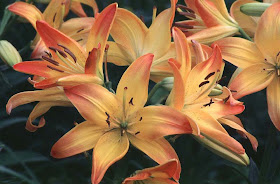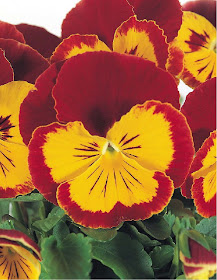Hemerocallis x 'Catherine Neal'
Daylily
Type Perennial
Hardy range 2A to 6A
Height 24" to 36" / 60cm to 90cm
Spread 24" to 4' / 60cm to 1.20m
Growth rate Average
Form Irregular or sprawling and upright or erect
Exposure Partial shade or partial sun to full sun
Persistence Deciduous
Bloom Color Purple
Bloom Time Summer
The flowers are suitable for cut flowers.
This plant will grow in moist soil.
Suitable soil is well-drained/loamy, sandy or clay.
The pH preference is an acidic to neutral (less than 6.8 to 7.2) soil.
Leaf Color Green
Fall Color No change in fall color
This plant has attractive foliage.
Culture Notes
Hemerocallis hybrids come in a wide range of colors, flowering times and sizes, and some even come with a fragrance. For the most part, daylilies are long-lived, hardy perennials that are tolerant of the sun. However, some species will show sun scald and prefer partial sun. Daylilies are adaptable to a wide range of soil conditions, and most bloom from late June until the first frost (depending on the cultivar). These plants attract both butterflies and hummingbirds and, usually, are both heat and drought resistant. Hemerocallis are extremely tough plants that spread rapidly in most conditions, thereby choking out weeds without becoming invasive themselves. The best time to plant daylilies is early spring. Although the individual blooms are short-lived, the number of blooms you get from an average flower stalk continues on for weeks.
Daylilies adapt to almost any location that provides at least six hours of sunlight, but it's best to plant them in a prepared, raised bed of soil that is high in organic matter. For clay soil, coarse sand and organic matter should be mixed in. When planted, the crown should be even with the soil line. The growth rate of daylilies can be increased via generous irrigation practices. At the end of the flowering season, remove the spent flower stalks only so that the remaining dying foliage will protect the center of the plant through the colder winter months. Also, division of the plant every two or three years will increase stem strength and flower size.
'Catherine Neal' has won several awards from the American Hemerocallis Society, including an Honorable Mention in 1983 and the Award of Merit in 1990. Its bloom color is deep purple with a greenish center. Despite its dark color, 'Catherine Neal' fades very little in the sun. This particular Daylily is usually a repeat bloomer, and it goes dormant in the winter months.
Hemerocallis x 'Janice Brown'
Daylily
Type Perennial
Hardy range 3A to 10AHeight 12" to 18" / 30cm to 45cm
Spread 24" to 4' / 60cm to 1.20m
Growth rate Average
Form Irregular or sprawling and upright or erect
Exposure Partial shade or partial sun to full sun
Persistence Deciduous
Bloom Color Pink
The flowers are suitable for cut flowers.
EnvironmentThis plant tolerates drought.
This plant will grow in moist soil.
Suitable soil is well-drained/loamy, sandy or clay.
The pH preference is an acidic to neutral (less than 6.8 to 7.2) soil.
Leaf Color Green
Fall Color No change in fall color
This plant has attractive foliage.
Culture NotesHemerocallis hybrids come in a wide range of colors, flowering times and sizes, and some even come with a fragrance. For the most part, daylilies are long-lived, hardy perennials that are tolerant of the sun. However, some species will show sun scald and prefer partial sun. Daylilies are adaptable to a wide range of soil conditions, and most bloom from late June until the first frost (depending on the cultivar). These plants attract both butterflies and hummingbirds and, usually, are both heat and drought resistant. Hemerocallis are extremely tough plants that spread rapidly in most conditions, thereby choking out weeds without becoming invasive themselves. The best time to plant daylilies is early spring. Although the individual blooms are short-lived, the number of blooms you get from an average flower stalk continues on for weeks.
Daylilies adapt to almost any location that provides at least six hours of sunlight, but it's best to plant them in a prepared, raised bed of soil that is high in organic matter. For clay soil, coarse sand and organic matter should be mixed in. When planted, the crown should be even with the soil line. The growth rate of daylilies can be increased via generous irrigation practices. At the end of the flowering season, remove the spent flower stalks only so that the remaining dying foliage will protect the center of the plant through the colder winter months. Also, division of the plant every two or three years will increase stem strength and flower size.
'Janice Brown' won the American Hemerocallis Society's highest honors by receiving the Stout Silver Medal.
Hemerocallis x 'Frans Hals'
Daylily
Type Perennial
Hardy range 4B to 8A
Height 24" to 28" / 60cm to 70cm
Spread 24" to 4' / 60cm to 1.20m
Growth rate Average
Form Irregular or sprawling
Exposure Partial shade or partial sun to full sun
Persistence Deciduous
Bloom Color Orange and yellow
Bloom Time Summer and Fall
Environment This plant tolerates drought.
This plant will grow in moist soil.
Suitable soil is well-drained/loamy.
The pH preference is a neutral soil.
Leaf Color Green
This plant has attractive foliage.
Culture Notes Hemerocallis hybrids are tolerant of full sun, but sometimes they will show sun scald in hot areas and prefer partial sun. Most are tolerant of a wide range of soil conditions.
Hemerocallis x 'Fairy Tale Pink'
Daylily
Type Perennial
Hardy range 2A to 6A
Height 12" to 24" / 30cm to 60cm
Spread 24" to 4' / 60cm to 1.20m
Growth rate Average
Form Irregular or sprawling and upright or erect
Exposure Partial shade or partial sun to full sun
Persistence Deciduous and semi-evergreen
Bloom Color Pink
Bloom Time Summer
Environment This plant tolerates drought.
This plant will grow in moist soil.
Suitable soil is well-drained/loamy, sandy or clay.
The pH preference is an acidic to neutral (less than 6.8 to 7.2) soil.
Leaf Color Green
Fall Color No change in fall color
This plant has attractive foliage.
Culture Notes Hemerocallis hybrids come in a wide range of colors, flowering times and sizes, and some even come with a fragrance. For the most part, daylilies are long-lived, hardy perennials that are tolerant of the sun. However, some species will show sun scald and prefer partial sun. Daylilies are adaptable to a wide range of soil conditions, and most bloom from late June until the first frost (depending on the cultivar). These plants attract both butterflies and hummingbirds and, usually, are both heat and drought resistant. Hemerocallis are extremely tough plants that spread rapidly in most conditions, thereby choking out weeds without becoming invasive themselves. The best time to plant daylilies is early spring. Although the individual blooms are short-lived, the number of blooms you get from an average flower stalk continues on for weeks.
Daylilies adapt to almost any location that provides at least six hours of sunlight, but it's best to plant them in a prepared, raised bed of soil that is high in organic matter. For clay soil, coarse sand and organic matter should be mixed in. When planted, the crown should be even with the soil line. The growth rate of daylilies can be increased via generous irrigation practices. At the end of the flowering season, remove the spent flower stalks only so that the remaining dying foliage will protect the center of the plant through the colder winter months. Also, division of the plant every two or three years will increase stem strength and flower size.
'Fairy Tale Pink' is the winner of several American Hemerocallis Society awards, including an Honorable Mention in 1984, an Award of Merit in 1987 and the much sought after Stout Silver Medal in 1990. Its ruffled creamy-pink coloring, green throat, form, resistance to sun damage and ability to repeat blooming makes the 'Fairy Tale Pink' quite popular. As a semi-evergreen, this plant becomes dormant during the winter months.
Hemerocallis x 'Cherry Cheeks'
Daylily
Type Perennial
Hardy range 4B to 8A
Height 24" to 30" / 60cm to 75cm
Spread 24" to 4' / 60cm to 1.20m
Growth rate Average
Form Irregular or sprawling
Exposure Partial shade or partial sun to full sun
Persistence DeciduousBloom Color Pink
Bloom Time Summer and Fall
The flowers are fragrant and suitable for cut flowers.
Environment This plant tolerates drought.
This plant will grow in moist soil.
Suitable soil is well-drained/loamy.
The pH preference is a neutral soil.
Leaf Color Green
This plant has attractive foliage.
Culture Notes Hemerocallis hybrids are tolerant of full sun, but sometimes they will show sun scald in hot areas and prefer partial sun. Most are tolerant of a wide range of soil conditions.
Please feel free to comment on any post at any time all feedback is welcome and we’d love to hear it.

























